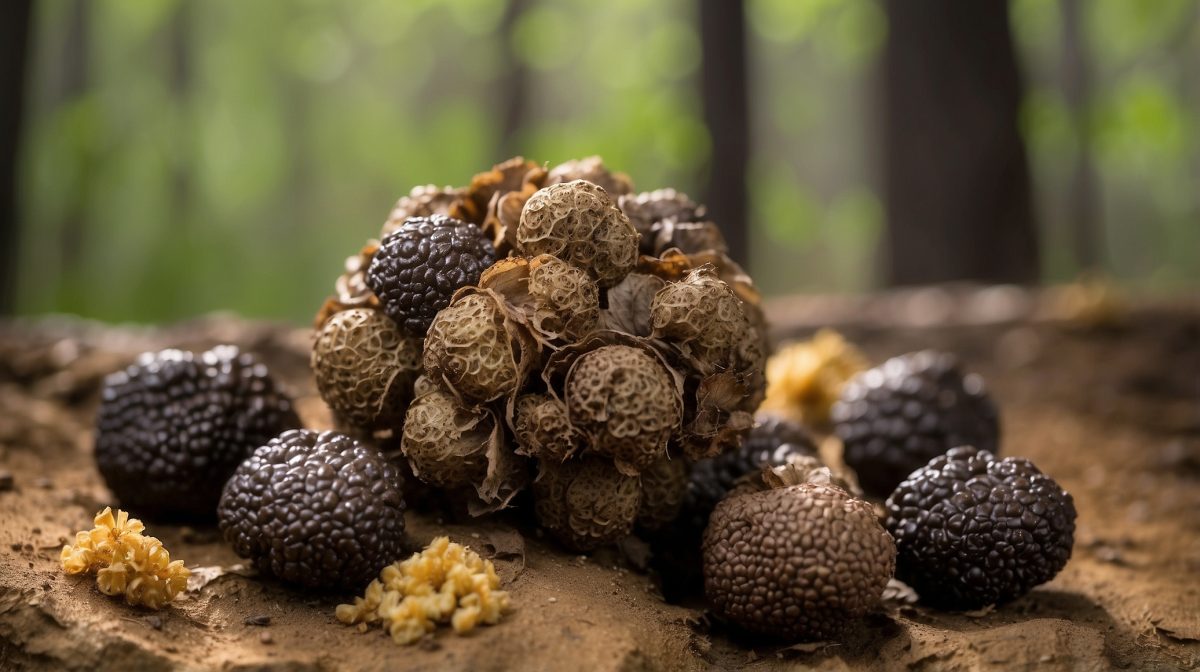Now, I know what you’re thinkin’ – truffles, here in Texas? But hold your horses, because there’s more to this story. Truffles have been the talk of the town from high-end restaurants to local farmer markets, and it ain’t just because they taste good. They represent a niche in agriculture that could mean big bucks and a whole lot of pride for local growers. So let’s get down to the nitty-gritty and explore the possibility of growin’ truffles right here in our backyard.
The Lore of Truffles
Truffles have been a part of culinary history for centuries, with a reputation that’s as rich as their flavor. These prized fungi have been sought after by kings and commoners alike, and they’ve been the darlings of haute cuisine for as long as anyone can remember. The hunt for truffles, often with the help of trained dogs or pigs, is as much a part of their mystique as their elusive growing conditions. They’re not just mushrooms; they’re a symbol of luxury and the high life.
Now, the thing about truffles is that they’ve got a certain air of mystery to ’em. They grow underground, in the wild, and finding them ain’t always easy. That’s why they fetch such a pretty penny. But it’s not just the hunt that’s got folks talkin’; it’s the potential for cultivating them that’s got us intrigued. With the world’s appetite for these fancy fungi only gettin’ bigger, the idea of growin’ them on our own turf is mighty appealing.
Truffles in Texas Hill Country
Let’s talk dirt, y’all – specifically, the soil and climate of our beloved Texas Hill Country. It’s no secret that we’ve got some of the most diverse and rich land in the state. But when it comes to growin’ truffles, we’ve got to ask ourselves: do we have the right stuff? Truffles need well-drained soil, a bit of limestone perhaps, and a climate that ain’t too hot nor too cold. It’s a tall order, but not outside the realm of possibility for our versatile region.
Comparin’ our neck of the woods to the traditional truffle-growing regions of Europe, we’ve got some similarities but also some differences. The experts have been weighin’ in on this, and the consensus seems to be that, with the right approach, we might just be able to cultivate these underground treasures. It’s an exciting prospect, and one that could see Texas Hill Country become a new frontier for truffle farming.
The Truffle Cultivation Process
Growin’ truffles ain’t like plantin’ your typical garden vegetables; it’s more akin to a scientific endeavor mixed with a dash of old-fashioned patience. The process starts with truffle spores, which need to cozy up with the roots of certain host trees to produce the goods. It’s a symbiotic relationship that requires the right match to flourish. In Texas Hill Country, we’ve got to be choosy about the trees we plant to give these truffles a fighting chance.
And let’s talk about patience – it’s not just a virtue, it’s a requirement. Truffle spores can take years to mature into the fragrant morsels we’re after. We’re talkin’ about a timeline that stretches further than the eye can see at a high noon showdown. But for those willing to wait, the payoff could be as big as Texas itself. It’s all about playin’ the long game and stayin’ committed to the cause.
Challenges and Considerations
Now, I won’t sugarcoat it – truffle farming is a bit of a gamble. It requires a hefty upfront investment and there’s no guarantee of success. The risks are as real as a Texas thunderstorm, but so are the potential rewards. Truffle farmers face challenges like pests, diseases, and the ever-present uncertainty of Mother Nature. And right here in Texas Hill Country, we’ll have our own unique set of hurdles to clear.
But we’re a resourceful bunch, and there are ways to tilt the odds in our favor. Innovations in farming practices and a deep understanding of our local environment can help us navigate the tricky waters of truffle cultivation. It’s about bein’ smart, takin’ calculated risks, and sometimes, just havin’ the guts to try somethin’ new. With a little bit of that Texas grit, we might just make it work.
Success Stories and Experiments
Now, we’re not the first cowboys to ride this rodeo. There have been success stories from folks growin’ truffles in climates similar to ours, and these tales give us hope. These pioneers have shown that with the right conditions and a heap of hard work, truffles can indeed be coaxed from the ground. And right here in Texas Hill Country, there are experiments and pilot projects underway to test the truffle-growing waters.
As for me, I’ve seen the potential firsthand near the JL Bar Ranch Resort. Local farmers, includin’ myself, are explorin’ the possibilities and sharin’ insights that could pave the way for a truffle boom. It’s a community effort, and the excitement is as palpable as the heat on a summer’s day. We’re all watchin’ with bated breath to see if these experiments will lead to a truffle triumph.
Conclusion
In summation, my friends, the question of whether we can grow truffles in the Texas Hill Country is met with a hopeful “maybe.” It’s a venture that’s ripe with possibility and could very well bring a new era of prosperity to our local agriculture and economy. We’re standin’ on the edge of a potentially delicious frontier, and the view is as tantalizing as a plate of truffle fries at a fancy steakhouse.
So let’s tip our hats to the future and the promise it holds. With a little bit of luck, a whole lot of science, and that indomitable Texas spirit, we might just find ourselves at the forefront of a truffle revolution. And wouldn’t that be somethin’ to write home about?
FAQs
What kind of truffles could potentially grow well in Texas Hill Country?
The black Périgord truffle and the Burgundy truffle are two varieties that experts believe have the potential to thrive in our region, given the right conditions.
How long does it take for truffle spores to mature into harvestable truffles?
Truffle spores can take anywhere from 7 to 10 years to mature into truffles that are ready for harvest, so patience is a must.
Are there any truffle orchards currently in Texas Hill Country?
Yes, there are a few pioneering truffle orchards in the area, with farmers conducting experiments and pilot projects to test the viability of truffle cultivation.
What are the initial steps to start a truffle farm?
Starting a truffle farm involves selecting the right tree species, inoculating them with truffle spores, and preparing the land with the appropriate soil conditions for truffle growth.
Can truffle cultivation be a sustainable agricultural practice in our region?
With careful planning and management, truffle cultivation has the potential to be a sustainable agricultural practice that could benefit the economy and environment of Texas Hill Country.


